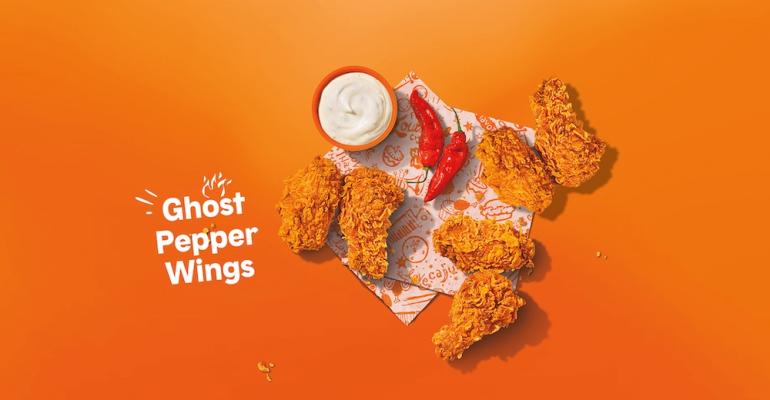Consumer concerns about the economy, from inflation to value perceptions, and a shaky supply chain are muscling their way into menu trends this year, a panel of experts concluded Wednesday.
The CREATE The Future of Foodservice “Menu Innovation: Top Trends for 2023” panel featured: Amy Alarcon, vice president of culinary Innovation at Popeyes Louisiana Kitchen; Owen Kline, vice president of global culinary innovation at CKE Restaurants, parent to the Carl’s Jr. and Hardee’s brands; and Alex Sadowsky, director for culinary and menu innovation for Twin Peaks restaurants.
The digital panel was moderated by Bret Thorn, Nation’s Restaurant News food and beverage editor, and sponsored by Entegra. A replay is available on the CREATE website.
“I think — more than anything — consumer behavior is definitely going to be affected by people just struggling to put food on the table or, at least, manage their budget,” said Alarcon of Popeyes, which is owned by Toronto-based Restaurant Brands International Inc.
“We want to make sure our guests can come to us and feel like they're getting a lot of food for a great price and feel like they're maximizing their dollar as much as possible,” Alarcon said. As of Sept. 30, Popeyes had 3,928 restaurants systemwide.
Klein said Carl’s Jr. and Hardee’s customers would be keeping an eye on value in 2023 but also, as the emerge from COVID19 restrictions, they would be looking to health aspects of meals. Franklin, Tenn.- based CKE Restaurants Holdings Inc owns Carl's Jr. Restaurants LLC and Hardee's Restaurants LLC and has more than 3,800 franchised and company-operated restaurants in 44 states and 43 foreign countries and U.S. territories.
“More of the general public is going back on the health train,” Klein said. “We've been comforting or fattening ourselves up over the last two and half years, so paying attention to what's a fad versus what's a trend.”
Customers are paying attention to carbohydrates and looking toward protein-heavy diets, he said.
Also, comfort foods continue to influence consumer trends along with value perception, said Sadowsky. Some trends will be impacted by world events, such as Russia’s war on the bread-basket country of Ukraine.
The unknown aspects of that war has already impacted the price and availability of mustard seeds, which remain a nascent trend, Sadowsky noted, and other ingredients such as sunflower oil.
“That unknown in Ukraine is still up in the air,” he said, “and that's a big what if for all of us.” Casual-dining Twin Peaks has more than 80 units and is owned by Los Angeles-based Fat Brands Inc.
Other menu trends noted by the panelists included:
- Fermentation techniques. “It's one of the top things in our innovation pipeline,” said Sadowsky, suggesting that the same effect can be achieved by adding sauces or vinegar elements.
- Korean flavors. Klein said fermented beans or bean paste and chiles can be added to dishes. “We've been working on ways to get Korean flavors into our menus for a couple of years now,” he said, “and I think we're on to something soon. Hint. Hint.”
- Pickled onions. Influenced by the taco truck culture and flavors in many cities, many menus are seeing the addition of pickled onions, Klein said.
- Attention to texture. Alarcon said Popeyes plays close attention to the mode cooking: The fried chicken crust, for example, must have a “shattery crunch.”
- Spice. Popeyes has introduced a ghost pepper sauce, Alarcon said, and the heat level has worked well for the brand, which introduced spicy chicken in 1972.
With the supply-chain shortages since the onset of the pandemic in March 2020, menu development requires special attention to product availability, panelists said.
“It's a new fire drill every week,” Alarcon said.
Klein said menu developers have to be nimble, which requires “simplifying a lot of specifications” with the development of new products.
“Every single new product that we've developed over the last, I don't know, 18 months to 24 months has a plan B and a plan C [for supply sourcing] now,” Klein said. “It has to, otherwise you don't have your major launch.”
Panelists were less excited about plant-based menu items, though they often include them as an option. Whole-muscle plant-alternatives are getting closer to the mark, they added.
Popeyes, for example, has found a Cajun red bean burger has sold well in the United Kingdom, Alarcon said, but the interest level has been lower in the United States.
“That feels a little bit more on brand for us,” she explained, “because when I think about plant-based my mind goes to more like a whole thing like is it a fried Portobello mushroom something like that and not trying to create a fake something. That goes against our DNA of whole muscle and fresh and hand-battered and -breaded.”
Contact Ron Ruggless at [email protected]
Follow him on Twitter: @RonRuggless

